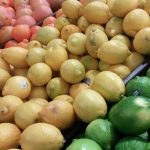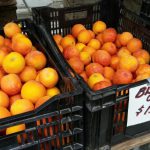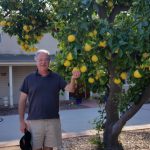 Down on the South Carolina shore, I was in my shirtsleeves contemplating a northeast weather forecast for temperatures in the teens with snow on the way. “These are Meyer lemons from our tree,” said my friend David. The bowl of glowing yellow fruit on the table denied the existence of winter and spoke of the endless summer of frost-free places, where sunshine hangs on the trees.
Down on the South Carolina shore, I was in my shirtsleeves contemplating a northeast weather forecast for temperatures in the teens with snow on the way. “These are Meyer lemons from our tree,” said my friend David. The bowl of glowing yellow fruit on the table denied the existence of winter and spoke of the endless summer of frost-free places, where sunshine hangs on the trees.
Even without a lemon tree in your yard, you can enjoy summery, refreshing oranges, grapefruits, and lemons. Winter is the high season for citrus. Just when we need it, these sunny fruits come to our rescue. Eaten fresh, squeezed for their juice, or flavoring a host of sweet treats, they’ll brighten up the drab months after the holidays.
Shipped from Florida, Texas, and California, citrus fruits come in a surprising variety of shapes, colors, and flavors.
Navel oranges, widely grown in California (think Orange County) are the standard supermarket sweet eating orange: Cara Cara oranges are a distinctive pinkish color inside and are less acidic; Blood oranges, originally from Sicily, have stunning dark red flesh.
Valencias, from Florida, are mostly squeezed for juice. Hybridized in California, the town of Valencia is named after the orange, not the other way around.
The Seville or bitter orange, seldom seen in stores, is used for making tart, tangy orange marmalade – a staple of the British Empire. Most come from the countries surrounding the Mediterranean.
Tangerines and Clementines are descendants of the ancient Mandarin orange. Easy to peel and section, these handy sized and flavorful oranges are perfect for snacking and are traditionally placed at the toe of Christmas stockings. Tangerines are named for the Moroccan port of Tangier, the departure point for oranges shipped to Europe in the 1800s.
Grapefruit is a cross between the sweet orange and the pomelo (a fruit near the top of the citrus family tree). Originally discovered on the island of Barbados, white grapefruit is widely grown in Florida, while Texas is known for its lower acid, brightly-colored pink grapefruits like Ruby Red and Rio Red – staples of school fundraisers.
The Meyer lemon, like the one in David’s yard, is a cross between lemon and orange and was brought to America from China by Frank Meyer, a staffer for the U.S. Department of Agriculture. Introduced to restaurant menus by California Chef Alice Waters and popularized by Martha Stewart, Meyers are prized for their sweeter, less acidic flavor, and fragrant skin.
Limes stand out for their bright green skin and affinity for gin. Key Limes, smaller and juicy with high acid and intense flavor, are the basic ingredient of Key Lime Pie. The juice is a light yellow, not green.
 It’s easy to take citrus fruits for granted. Pyramids of fruit stacked in stores year round next to the bananas – oranges, lemons and limes have become commodity fruits sold without regard for season or variety. Winter is the time of year when the fruits are best – fresh from the orchards. Choose fruit that feels heavy for its size, a sign of a juicy interior. Oranges and grapefruits should give a little when squeezed, neither hard nor mushy.
It’s easy to take citrus fruits for granted. Pyramids of fruit stacked in stores year round next to the bananas – oranges, lemons and limes have become commodity fruits sold without regard for season or variety. Winter is the time of year when the fruits are best – fresh from the orchards. Choose fruit that feels heavy for its size, a sign of a juicy interior. Oranges and grapefruits should give a little when squeezed, neither hard nor mushy.
There was a time when oranges were exotic and desirable. Beginning in the 17th century, European nobility built Orangeries at their palaces. These elaborate and prestigious green houses enabled them to grow and enjoy oranges, limes and lemons in their cold climate. One of the most famous was built at Potsdam outside of Berlin by Frederick William IV starting in 1851.
In Laura Ingalls Wilder’s popular Little House books, the kids who live on the edge of American expansion are dazzled by the sight and flavor of an orange. This everyday fruit was an exotic treat just a few generations ago.
As with any food, fresh picked fruit from small growers is likely to taste better. I once had the chance to buy a bag of oranges from a small roadside grove west of Paso Robles, CA. The fruit had a sweet-tart complexity notably different and more enjoyable than supermarket examples.
At the Berkeley Bowl, an independent California supermarket famous for its produce selection, the citrus aisle is comprehensive and a little overwhelming. Close to the source, they’re able to get all kinds. Bumpy, irregularly shaped, and unusually colored fruit, alongside the familiar varieties – this citrus section was unique.
If you live in a frost-free zone, you may be able to have your own citrus grove. Like the European nobility, you can enjoy fruit plucked right from the tree. Growing citrus trees can be tricky, though. They don’t like frost, don’t want it too hot, and need plenty of water. Our son in the Los Angeles area has some well-established grapefruit trees in the front yard, but has been having trouble starting new trees in the hot, dry weather of the last few years.
Citrus trees can be a little confusing to us seasonally-oriented northerners. You often see blossoms and mature fruit on the tree at the same time. It’s’ also hard to tell when the fruit is ripe and ready for picking. Like apples, the citrus fruit will not ripen any further once it’s picked.
Looking for a little sunshine in the midst of cold, dark, January? Look no further than sunny citrus. Oranges, grapefruits, lemons and their many variations are in season now and will brighten up your winter.
















No Comment